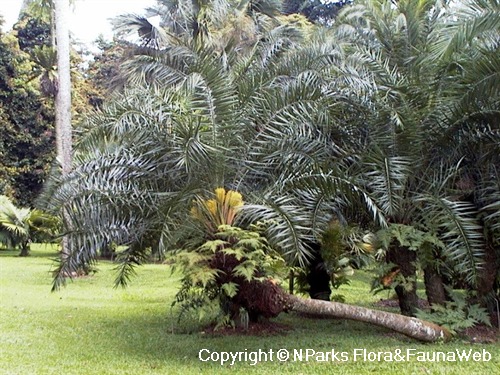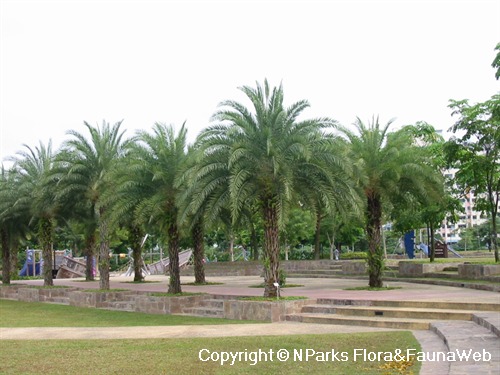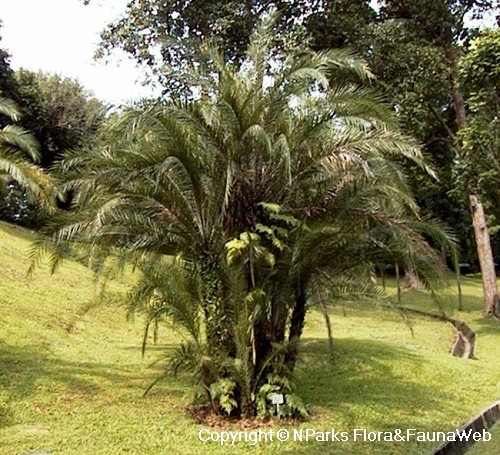
Back
Phoenix paludosa Roxb.
| Family Name: | Arecaceae (Palmae) |
| Synonyms: | Phoenix siamensis |
| Common Name: | Mangrove Date Palm |
Name
Classifications and Characteristics
| Plant Division | Angiosperms (Flowering Seed Plants) |
|---|---|
| Plant Growth Form | Palm (Clustered Habit) |
| Lifespan (in Singapore) | Perennial |
| Mode of Nutrition | Autotrophic |
| Plant Shape | Fountain (Palm-like) |
| Maximum Height | 4 m |
Biogeography
| Native Distribution | Southern Asia |
|---|---|
| Native Habitat | Shoreline |
| Preferred Climate Zone | Tropical |
Description and Ethnobotany
| Growth Form | Palm that grows up to 6-7 m tall. |
|---|---|
| Foliage | Compound, arching leaves are 2-3 m long and composed of light green leaflets that hang downwards. Leaflets are narrow and have a gray underside. They contain toxic compounds (Alam et al. 2009). |
| Fruit | Fleshy, purple to black fruits resemble berries and occur in clusters. |
| Habitat | Occurs in swampy jungles along the coast. |
Landscaping Features
| Landscape Uses | Coastal, Beachfront / Shoreline |
|---|---|
| Usage Hazard - Cons | Toxic Upon Ingestion |
Plant Care and Propagation
| Light Preference | Full Sun |
|---|---|
| Water Preference | Lots of Water |
| Plant Growth Rate | Moderate |
| Rootzone Tolerance | Waterlogged Soils, Saline Soils / Salt Spray |
| Propagation Method | Seed |
Foliar
| Mature Foliage Colour(s) | Green - Light Green |
|---|---|
| Foliar Type | Compound |
| Foliar Attachment to Stem | Petiolate |
| Foliar Shape(s) | Palm Fronds (Pinnate / Feather) |
| Foliar Margin | Entire |
| Leaf Area Index (LAI) for Green Plot Ratio | 4.0 (Palm - Cluster) |
Non - Foliar and Storage
| Trunk Type (Palm) | Clustering Habit, Aboveground |
|---|
Fruit, Seed and Spore
| Mature Fruit Colour(s) | Purple, Black |
|---|
References
| References | Alam et al.. 2009. Phytochemcial and Biological Investigations of Phoenix paludosa Roxb.. Dhaka Univ. Journal of Pharmaceutical Science. 8. 7-10 Yong J, Tan PY, Nor Hafiz Hassan, Tan SN. 2010. A Selection of Plants for Greening of Waterways and Waterbodies in the Tropics. Singapore: Chung Printing . 480 pp. |
|---|
Image Repository
Others
| Master ID | 1370 |
|---|---|
| Species ID | 2663 |
| Flora Disclaimer | The information in this website has been compiled from reliable sources, such as reference works on medicinal plants. It is not a substitute for medical advice or treatment and NParks does not purport to provide any medical advice. Readers should always consult his/her physician before using or consuming a plant for medicinal purposes. |



